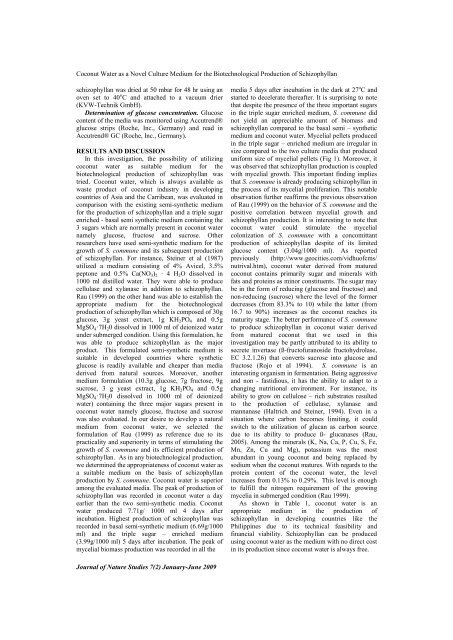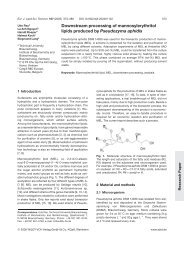COCO UT WATER AS A OVEL CULTURE MEDIUM FOR THE ...
COCO UT WATER AS A OVEL CULTURE MEDIUM FOR THE ...
COCO UT WATER AS A OVEL CULTURE MEDIUM FOR THE ...
You also want an ePaper? Increase the reach of your titles
YUMPU automatically turns print PDFs into web optimized ePapers that Google loves.
Coconut Water as a Novel Culture Medium for the Biotechnological Production of Schizophyllan<br />
schizophyllan was dried at 50 mbar for 48 hr using an<br />
oven set to 40 o C and attached to a vacuum drier<br />
(KVW-Technik GmbH).<br />
Determination of glucose concentration. Glucose<br />
content of the media was monitored using Accutrend®<br />
glucose strips (Roche, Inc., Germany) and read in<br />
Accutrend® GC (Roche, Inc., Germany).<br />
RESULTS AD DISCUSSIO<br />
In this investigation, the possibility of utilizing<br />
coconut water as suitable medium for the<br />
biotechnological production of schizophyllan was<br />
tried. Coconut water, which is always available as<br />
waste product of coconut industry in developing<br />
countries of Asia and the Carribean, was evaluated in<br />
comparison with the existing semi-synthetic medium<br />
for the production of schizophyllan and a triple sugar<br />
enriched - basal semi synthetic medium containing the<br />
3 sugars which are normally present in coconut water<br />
namely glucose, fructose and sucrose. Other<br />
researchers have used semi-synthetic medium for the<br />
growth of S. commune and its subsequent production<br />
of schizophyllan. For instance, Steiner et al (1987)<br />
utilized a medium consisting of 4% Avicel, 3.5%<br />
peptone and 0.5% Ca(NO 3 ) 2 · 4 H 2 O dissolved in<br />
1000 ml distilled water. They were able to produce<br />
cellulase and xylanase in addition to schizophyllan.<br />
Rau (1999) on the other hand was able to establish the<br />
appropriate medium for the biotechnological<br />
production of schizophyllan which is composed of 30g<br />
glucose, 3g yeast extract, 1g KH 2 PO 4 and 0.5g<br />
MgSO 4·7H 2 0 dissolved in 1000 ml of deionized water<br />
under submerged condition. Using this formulation, he<br />
was able to produce schizophyllan as the major<br />
product. This formulated semi-synthetic medium is<br />
suitable in developed countries where synthetic<br />
glucose is readily available and cheaper than media<br />
derived from natural sources. Moreover, another<br />
medium formulation (10.3g glucose, 7g fructose, 9g<br />
sucrose, 3 g yeast extract, 1g KH 2 PO 4 and 0.5g<br />
MgSO 4·7H 2 0 dissolved in 1000 ml of deionized<br />
water) containing the three major sugars present in<br />
coconut water namely glucose, fructose and sucrose<br />
was also evaluated. In our desire to develop a natural<br />
medium from coconut water, we selected the<br />
formulation of Rau (1999) as reference due to its<br />
practicality and superiority in terms of stimulating the<br />
growth of S. commune and its efficient production of<br />
schizophyllan. As in any biotechnological production,<br />
we determined the appropriateness of coconut water as<br />
a suitable medium on the basis of schizophyllan<br />
production by S. commune. Coconut water is superior<br />
among the evaluated media. The peak of production of<br />
schizophyllan was recorded in coconut water a day<br />
earlier than the two semi-synthetic media. Coconut<br />
water produced 7.71g/ 1000 ml 4 days after<br />
incubation. Highest production of schizophyllan was<br />
recorded in basal semi-synthetic medium (6.69g/1000<br />
ml) and the triple sugar – enriched medium<br />
(3.99g/1000 ml) 5 days after incubation. The peak of<br />
mycelial biomass production was recorded in all the<br />
media 5 days after incubation in the dark at 27 o C and<br />
started to decelerate thereafter. It is surprising to note<br />
that despite the presence of the three important sugars<br />
in the triple sugar enriched medium, S. commune did<br />
not yield an appreciable amount of biomass and<br />
schizophyllan compared to the basal semi – synthetic<br />
medium and coconut water. Mycelial pellets produced<br />
in the triple sugar – enriched medium are irregular in<br />
size compared to the two culture media that produced<br />
uniform size of mycelial pellets (Fig 1). Moreover, it<br />
was observed that schizophyllan production is coupled<br />
with mycelial growth. This important finding implies<br />
that S. commune is already producing schizophyllan in<br />
the process of its mycelial proliferation. This notable<br />
observation further reaffirms the previous observation<br />
of Rau (1999) on the behavior of S. commune and the<br />
positive correlation between mycelial growth and<br />
schizophyllan production. It is interesting to note that<br />
coconut water could stimulate the mycelial<br />
colonization of S. commune with a concomittant<br />
production of schizophyllan despite of its limited<br />
glucose content (3.04g/1000 ml). As reported<br />
previously (http://www.geocities.com/vidhuofcms/<br />
nutrival.htm), coconut water derived from matured<br />
coconut contains primarily sugar and minerals with<br />
fats and proteins as minor constituents. The sugar may<br />
be in the form of reducing (glucose and fructose) and<br />
non-reducing (sucrose) where the level of the former<br />
decreases (from 83.3% to 10) while the latter (from<br />
16.7 to 90%) increases as the coconut reaches its<br />
maturity stage. The better performance of S. commune<br />
to produce schizophyllan in coconut water derived<br />
from matured coconut that we used in this<br />
investigation may be partly attributed to its ability to<br />
secrete invertase (ß-fructofuranoside fructohydrolase,<br />
EC 3.2.1.26) that converts sucrose into glucose and<br />
fructose (Rojo et al 1994). S. commune is an<br />
interesting organism in fermentation. Being aggressive<br />
and non - fastidious, it has the ability to adapt to a<br />
changing nutritional environment. For instance, its<br />
ability to grow on cellulose – rich substrates resulted<br />
to the production of cellulase, xylanase and<br />
mannanase (Haltrich and Steiner, 1994). Even in a<br />
situation where carbon becomes limiting, it could<br />
switch to the utilization of glucan as carbon source<br />
due to its ability to produce ß- glucanases (Rau,<br />
2005). Among the minerals (K, Na, Ca, P, Cu, S, Fe,<br />
Mn, Zn, Cu and Mg), potassium was the most<br />
abundant in young coconut and being replaced by<br />
sodium when the coconut matures. With regards to the<br />
protein content of the coconut water, the level<br />
increases from 0.13% to 0.29%. This level is enough<br />
to fulfill the nitrogen requirement of the growing<br />
mycelia in submerged condition (Rau 1999).<br />
As shown in Table 1, coconut water is an<br />
appropriate medium in the production of<br />
schizophyllan in developing countries like the<br />
Philippines due to its technical feasibility and<br />
financial viability. Schizophyllan can be produced<br />
using coconut water as the medium with no direct cost<br />
in its production since coconut water is always free.<br />
Journal of ature Studies 7(2) January-June 2009



